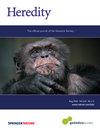Transcriptomic basis of within- and trans-generational predator-induced plasticity in the freshwater snail Physa acuta
IF 3.9
2区 生物学
Q2 ECOLOGY
引用次数: 0
Abstract
Inducible defences in response to predation risk are a well-known example of adaptive phenotypic plasticity. Although inducible defences have been studied mainly within a generation (within-generational plasticity), there is now clear evidence that ancestral exposure to predation risk can influence the defences expressed by offspring, even if they have not been exposed themselves (transgenerational plasticity). The molecular mechanisms allowing the transmission of environmental information across generations are not well understood. In this study, we combined measures of antipredator responses (behavioural and morphological) with transcriptomic investigations across two generations in the freshwater snail Physa acuta. We hypothesised that both within- and transgenerational plasticity would induce phenotypic changes associated with differential gene expression. Our results confirmed within- and transgenerational plasticity: F1 snails respond to predator-cue exposure by increasing escape behaviour, reducing shell length, and developing thicker and slenderer shells, whereas F2 snails from exposed parents have longer and thicker shells with narrower apertures. Within- and transgenerational plasticity were accompanied by the differential expression of 112 genes (101 up- and 11 downregulated) and 23 differentially expressed genes (17 up- and 6 downregulated), respectively. Within- and transgenerational plasticity did not share common differentially expressed genes, but the associated molecular functions, involving metabolism and transcription regulation, were similar. These results suggest that predator-induced within-generational plasticity and transgenerational plasticity may result from different genomic pathways and may evolve independently.

淡水蜗牛acuta的代际和跨代捕食者诱导可塑性的转录组学基础。
对捕食风险的诱导防御是适应性表型可塑性的一个众所周知的例子。虽然诱导防御主要是在一代内(代内可塑性)进行研究,但现在有明确的证据表明,祖先暴露于捕食风险会影响后代表达的防御,即使他们自己没有暴露(跨代可塑性)。允许环境信息跨代传递的分子机制尚不清楚。在这项研究中,我们将两代淡水蜗牛(Physa acuta)的反捕食反应(行为和形态学)与转录组学研究相结合。我们假设代际内和跨代可塑性都会诱导与差异基因表达相关的表型变化。我们的研究结果证实了内代和跨代的可塑性:F1蜗牛对捕食者线索暴露的反应是增加逃跑行为,减少外壳长度,发育出更厚更细的外壳,而来自暴露父母的F2蜗牛的外壳更长更厚,孔径更窄。代内可塑性和跨代可塑性分别伴随着112个基因(101个上调,11个下调)和23个差异表达基因(17个上调,6个下调)的差异表达。内代和跨代可塑性没有共同的差异表达基因,但相关的分子功能,包括代谢和转录调节,是相似的。这些结果表明,捕食者诱导的代内可塑性和跨代可塑性可能来自不同的基因组途径,并可能独立进化。
本文章由计算机程序翻译,如有差异,请以英文原文为准。
求助全文
约1分钟内获得全文
求助全文
来源期刊

Heredity
生物-进化生物学
CiteScore
7.50
自引率
2.60%
发文量
84
审稿时长
4-8 weeks
期刊介绍:
Heredity is the official journal of the Genetics Society. It covers a broad range of topics within the field of genetics and therefore papers must address conceptual or applied issues of interest to the journal''s wide readership
 求助内容:
求助内容: 应助结果提醒方式:
应助结果提醒方式:


